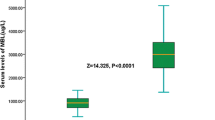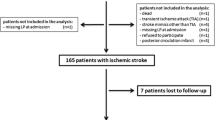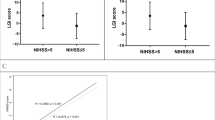Abstract
Complement activation and inflammation have been suggested in the pathogenesis of stroke; mannose-binding lectin (MBL) was found to have roles during the process. We therefore evaluated the short-term prognostic value of serum MBL in Chinese patients with an acute ischemic stroke (AIS). Consecutive AIS patients admitted to the emergency department were identified. Clinical information was collected. Serum concentration of MBL and NIH Stroke Scale (NIHSS) was measured at the time of admission. Short-term functional outcome was measured by modified Rankin scale (mRS) 90 days after admission. Multivariate analyses were performed using logistic regression models. During the inclusion period, 231 patients were diagnosed with AIS, and 220 completed follow-up. The results indicated that the serum MBL levels were significantly (P = 0.000) higher in acutely ischemic stroke patients as compared with normal controls. MBL was an independent prognostic marker of short-term functional outcome and death (odds ratio (OR) 5.28 (2.88–10.67) and 6.99 (3.55–13.97), respectively, P = 0.000 for both, adjusted for NIHSS, other predictors, and vascular risk factors) in patients with AIS. MBL improved the area under the receiver operating characteristic curve of the NIHSS score for functional outcome from 0.826 (95 % CI 0.773–0.879) to 0.857 (95 % CI 0.808–0.905, P = 0.000) and for mortality from 0.768 (95 % CI 0.682–0.853) to 0.822 (95 % CI 0.747–0.896, P = 0.000). Serum MBL levels are a useful, complementary tool to predict functional outcome and mortality 90 days after stroke.



Similar content being viewed by others
References
Macrez R, Ali C, Toutirais O, Le Mauff B, Defer G, Dirnagl U et al (2011) Stroke and the immune system: from pathophysiology to new therapeutic strategies. Lancet Neurol 10:471–480
Iadecola C, Anrather J (2011) The immunology of stroke: from mechanisms to translation. Nat Med 17:796–808
Hansson GK, Hermansson A (2011) The immune system in atherosclerosis. Nat Immunol 12:204–212
Frauenknecht V, Thiel S, Storm L, Meier N, Arnold M, Schmid JP et al (2013) Plasma levels of mannan-binding lectin (MBL)-associated serine proteases (MASPs) and MBL-associated proteinin cardio- and cerebrovascular diseases. Clin Exp Immunol 173:112–120
Keller TT, van Leuven SI, Meuwese MC, Wareham NJ, Luben R, Stroes ES et al (2006) Serum levels of mannose-binding lectin and the risk of future coronary artery disease in apparently healthy men and women. Arterioscler Thromb Vasc Biol 26:2345–2350
Hansen TK, Forsblom C, Saraheimo M, Thorn L, Wadén J, Høyem P et al (2010) Association between mannose-binding lectin, high-sensitivity C-reactive protein and the progression of diabetic nephropathy in type 1 diabetes. Diabetologia 53:1517–1524
Hovind P, Hansen TK, Tarnow L, Thiel S, Steffensen R, Flyvbjerg A et al (2005) Mannose-binding lectin as a predictor of microalbuminuria in type 1 diabetes: an inception cohort study. Diabetes 54:1523–1527
Turner MW (2003) The role of mannose-binding lectin in health and disease. Mol Immunol 40:423–429
Wang ZY, Sun ZR, Zhang LM (2014) The relationship between serum mannose-binding lectin levels and acute ischemic stroke risk. Neurochem Res 39:248–253
Osthoff M, Katan M, Fluri F, Schuetz P, Bingisser R, Kappos L et al (2011) Mannose-binding lectin deficiency is associated with smaller infarction size and favorable outcome in ischemic stroke patients. PLoS ONE 6:e21338
Hatano S (1976) Experience from a multicentre stroke register: a preliminary report. Bull World Health Organ 54:541–553
Brott T, Adams HP Jr, Olinger CP et al (1989) Measurements of acute cerebral infarction: a clinical examination scale. Stroke 20:864–870
Adams HP, Bendixen BH, Kappelle L (1993) J, et al. Classification of subtype of acute ischemic stroke. Definitions for use in a multicenter clinical trial. TOAST. Trial of Org 10172 in Acute Stroke Treatment. Stroke 24:35–41
Bamford J, Sandercock P, Dennis M et al (1991) Classification and natural history of clinically identifiable subtypes of cerebral infarction. Lancet 337:1521–1526
Bonita RBR (1988) Modification of Rankin Scale: recovery of motor function after stroke. Stroke 19:1497–1500
Sims JR, Gharai L (2009) R, Schaefer, P.W, et al. ABC/2 for rapid clinical estimate of infarct, perfusion, and mismatch volumes. Neurology 72:2104–2110
Hansen TK, Thiel S, Wouters PJ, Christiansen JS, Van den Berghe G (2003) Intensive insulin therapy exerts antiinflammatory effects in critically ill patients and counteracts the adverse effect of low mannose-binding lectin levels. J Clin Endocrinol Metab 88:1082–1088
Katan M, Fluri F, Morgenthaler NG, Schuetz P, Zweifel C, Bingisser R, Müller K, Meckel S, Gass A, Kappos L, Steck AJ, Engelter ST, Müller B, Christ-Crain M (2009) Copeptin: a novel, independent prognostic marker in patients with ischemic stroke. Ann Neurol 66:799–808
Pencina MJ, D’Agostino RB Sr, D’Agostino RB Jr, Vasan RS (2008) Evaluating the added predictive ability of a new marker: from area under the ROC curve to reclassification and beyond. Stat Med 27(157–172):207–212
Goldstein LB, Simel DL (2005) Is this patient having a stroke? JAMA 293:2391–2402
Carroll KE, Dean MM, Heatley SL, Meehan AC, Mifsud NA, Kotsimbos TC et al (2011) High levels of mannose-binding lectin are associated with poor outcomes after lung transplantation. Transplantation 91:1044–1049
Trendelenburg M, Theroux P, Stebbins A, Granger C, Armstrong P, Pfisterer M (2010) Influence of functional deficiency of complement mannose-binding lectin on outcome of patients with acute ST-elevation myocardial infarction undergoing primary percutaneous coronary intervention. Eur Heart J 31:1181–1187
Cervera A, Planas AM, Justicia C et al (2010) Genetically-defined deficiency of mannose-binding lectin is associated with protection after experimental stroke in mice and outcome in human stroke. PLoS One 5:e8433
Verma S, Szmitko PE, Ridker PM (2005) C-reactive protein comes of age. Nat Clin Pract Cardiovasc Med 2:29–36
Hansen TK, Tarnow L, Thiel S, Steffensen R, Stehouwer CD, Schalkwijk CG et al (2004) Association between mannose-binding lectin and vascular complications in type 1 diabetes. Diabetes 53:1570–1576
Speidl WS, Exner M, Amighi J, Kastl SP, Zorn G, Maurer G et al (2005) Complement component C5a predicts future cardiovascular events in patients with advanced atherosclerosis. Eur Heart J 26:2294–2299
La Bonte LR, Pavlov VI, Tan YS, Takahashi K, Takahashi M, Banda NK et al (2012) Mannose-binding lectin-associated serine protease-1 is a significant contributor to coagulation in a murine model of occlusive thrombosis. J Immunol 188:885–891
Ricklin D, Hajishengallis G, Yang K, Lambris JD (2010) Complement: a key system for immune surveillance and homeostasis. Nat Immunol 11:785–797
Fiane AE, Videm V, Lingaas PS, Heggelund L, Nielsen EW, Geiran OR et al (2003) Mechanism of complement activation and its role in the inflammatory response after thoracoabdominal aortic aneurysm repair. Circulation 108:849–856
Jack DL, Read RC, Tenner AJ, Frosch M, Turner MW, Klein NJ (2001) Mannose-binding lectin regulates the inflammatory response of human professional phagocytes to Neisseria meningitidis serogroup B. J Infect Dis 184:1152–1162
Nadesalingam J, Dodds AW, Reid KB, Palaniyar N (2005) Mannose-binding lectin recognizes peptidoglycan via the N-acetyl glucosamine moiety, and inhibits ligand-induced proinflammatory effect and promotes chemokine production by macrophages. J Immunol 175:1785–1794
Gulla KC, Gupta K, Krarup A, Gal P, Schwaeble WJ, Sim RB et al (2010) Activation of mannan-binding lectin-associated serine proteases leads to generation of a fibrin clot. Immunology 129:482–495
Jordan JE, Montalto MC, Stahl GL (2001) Inhibition of mannose-binding lectin reduces postischemic myocardial reperfusion injury. Circulation 104:1413–1418
Granger CB, Mahaffey KW, Weaver WD, Theroux P, Hochman JS, Filloon TG et al (2003) Pexelizumab, an anti-C5 complement antibody, as adjunctive therapy to primary percutaneous coronary intervention in acute myocardial infarction: the Complement Inhibition in Myocardial Infarction Treated with Angioplasty (COMMA) trial. Circulation 108:1184–1190
Acknowledgments
We thank Ping-Ya Liu, PhD, for the statistical advice and assistance with the qualitative measures used in this study. We also express our gratitude to all the patients who participated in this study, and thereby made this work possible.
Conflict of Interest
The authors have no relevant potential conflicts of interest to declare.
Author Contributions
Li LH had full access to all of the data in the study and takes responsibility for the integrity of the data and the accuracy of the data analysis. Study concept and design were done by Zhang ZG, Wang C, Wang J, Zhang Z, Yang YL, and Li LH. Acquisition of data was done by Zhang ZG, Gao L, Zhang XY, and Li LH. Analysis and interpretation of data were done by Wang C, Wang J, Chang T, and Gao GD. Drafting of the manuscript was done by Zhang ZG, Wang C, Wang J, and Li LH. Critical revision of the manuscript for important intellectual content was done by Zhang ZG and Li LH. Administrative, technical, or material support were funded by Zhang ZG, Wang C, Wang J, Zhang Z, Yang YL, Chang T, Gao GD, and Li LH. Study supervision was done by Li LH.
Author information
Authors and Affiliations
Corresponding author
Additional information
Zhi-Guo Zhang, Chao Wang, and Jing Wang contributed equally to this study.
Rights and permissions
About this article
Cite this article
Zhang, ZG., Wang, C., Wang, J. et al. Prognostic Value of Mannose-Binding Lectin: 90-Day Outcome in Patients with Acute Ischemic Stroke. Mol Neurobiol 51, 230–239 (2015). https://doi.org/10.1007/s12035-014-8682-0
Received:
Accepted:
Published:
Issue Date:
DOI: https://doi.org/10.1007/s12035-014-8682-0




